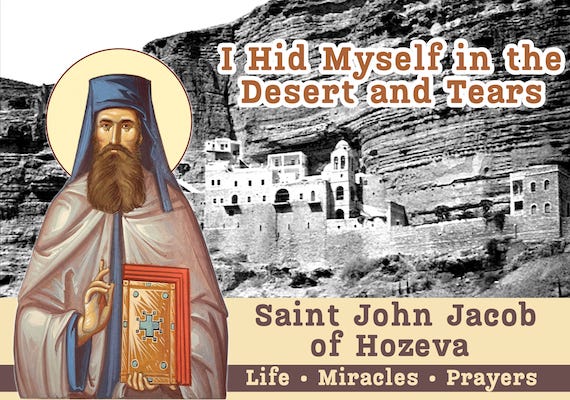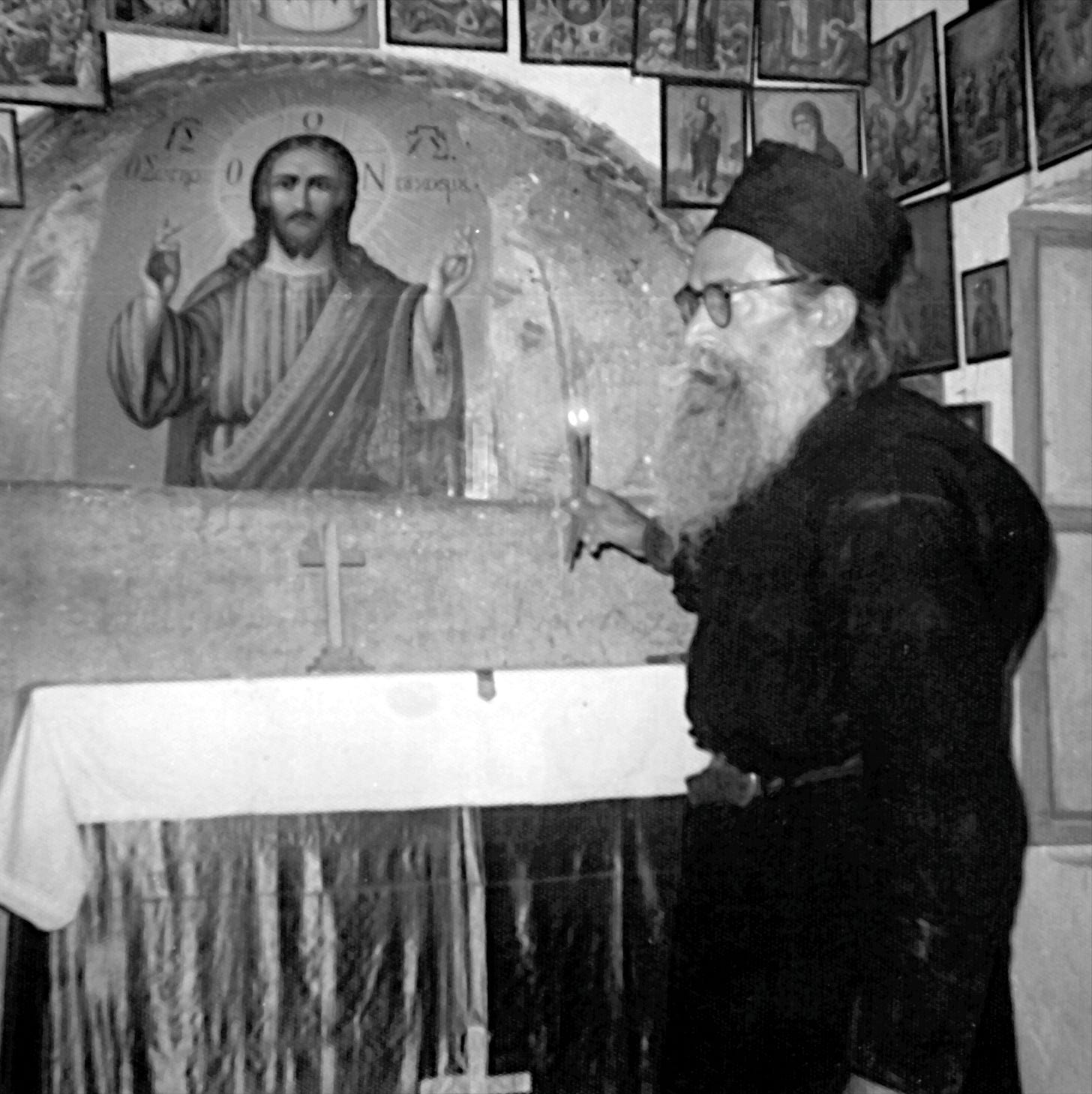St. John Jacob of Hozeva at St. Anna's Cave
Here are two sample chapters from a new book titled “I Hid Myself in the Desert and Tears” about the life, miracles, and prayers to Saint John Jacob of Hozeva—a contemporary Romanian hermit and grace-filled ascetic who struggled in the Holy Land and spent the last seven years of his life in a cave in the Hozeva Valley, “the Valley of the Shadow of Death.” The book was recently published by St. George Press.
At Hozeva Monastery
After the former hegumen of the Skete by the Jordan returned to the Skete, Father John and his disciple left for Saint George of Hozeva Monastery to find peace in the caves there.
At the Skete by the Jordan, he was surrounded by too many pilgrims and passing cares that impeded him from prayer and contemplation of divine things. He felt the need to be alone, to withdraw from people to be completely God’s, and to help the world with his prayer more than his words.
The Monastery of Saint George of Hozeva was established at the end of the 5th century by Saint John of Hozeva and experienced an extraordinary blossoming during the time of Saint George of Hozeva. This establishment is in Wadi Quilt, the Hozeva Desert, near the Horat brook, west of the Jordan. The Prophet Elias dwelt here while he was being persecuted by King Ahab (3 Kings 17).
The cave of Prophet Elias
Holy Tradition tells us that here, too, the Holy Virgin’s mother, Saint Anna, withdrew to a cave after the Mother of God was taken to the Temple in Jerusalem. Dwelling there until her death, Saint Anna was buried in the same cave. Only in 416, after Saint John’s disciples filled the Hozeva Valley, did Saint Anna reveal herself in a dream to a monk who lived in the cave in which she was buried. The monk told his dream to his abbot, and in this way, Saint Anna’s relics were discovered and the cave was turned into a church. At the time, this church was named the Skete of Saint Anna because the hermits living in the caves would serve and commune there on Sundays and feast days.
Out of love for Saint Anna, the monks built more monasteries and churches dedicated to her and began disseminating her holy relics. Only the Saint’s right leg remained at the church of this skete.
Before the Second World War, the monks of this skete withdrew to Holy Mount Athos. When they left, the monks took the Saint’s holy relics and brought them to Saint Anna’s Skete on Mount Athos, where they are kept to this day with great devotion.
The cave of Saint Anna and the cave in which the Holy Prophet Elias dwelt are part of the Monastery of Saint George of Hozeva.
There are many caves carved into the sheer cliff faces rising from both shores of the Hozeva brook.
The Monastery of Saint George of Hozeva
Saint John Jacob reached an agreement with the hegumen of Saint George of Hozeva Monastery, who promised to bring him needed food and help him fulfill his good desire. Venerable John arrived at the Monastery of Saint George in November 1952, and spent nearly a year in the brotherhood of this establishment.
†
The longing for the life of a hermit and the love of solitude consumed your soul, Holy Father John, for, thirsting for the limitless waves of Christ’s love, you withdrew from the paths of people in order to fully embrace them by the work of the Holy Spirit. Fortify the foundation of our mind with the words of the Gospel, so that sipping from the nectar of Christ’s commandments, we may understand at least a little of your asceticism’s secret.
At Saint Anna’s Cave
At the beginning of 1953, the monk Paul came to the monastery in Hozeva from Cyprus; he quickly formed a tight-knit spiritual friendship with Father John. He had a printing press and occupied himself with printing holy books. Venerable John decided to go to the caves of Saint Anna’s Skete together with him. So it happened that in the summer of 1953, Venerable John settled with his disciple in a nearby cave named “Saint Anna’s Cell.”
The cell in the Hozeva Valley where Venerable John struggled ascetically
Arriving there, Father Paul helped Saint John build a door and window in his small cell. He stayed in it for seven years, without going to the monastery or Jericho. He patiently bore the scorching summer days, when the desert’s heat is difficult to bear. He suffered terribly from rheumatism, struggling day and night with changing his shirts soaked in sweat that he could not bear to have dry on his skin, as he was too thin. He struggled in harsh asceticism, poverty, hidden tears, and many deep sighs for the suffering of the world and all people. He patiently bore everything that the Lord arranged for him to endure on this earth and consoled himself with the hope of things to come. In the summer, he suffered from the scorching sun, which reached 55 degrees Celsius[1], while in the winter, he endured the cold and dampness of the cave.
Venerable John (to the left of the photo) with Monk Paul in front of the cave in the Hozeva Valley
He nourished himself with rusks, salt, water, and rarely bread, olives, and figs–he tasted the latter only once a day, in the evening. He steadfastly read Divine Scripture and the writings of the Holy Fathers. He slept little, on a wooden board covered with a rug, being content with three or four hours of sleep and having a stone as a pillow. For most of the night, he persevered in vigil, being a man who knew the extraordinary power of prayer.
On feast days and great celebrations, Father John would go to Father Paul’s cell nearby to serve the Divine Liturgy in Saint Anna’s chapel. All three would commune: Venerable John, Father Paul, and Father Ioanichie.
Father Ioanichie Pârâială in front of the Holy Altar in Monk Paul’s cell, where Saint John would often serve the Divine Liturgy
†
The sheer cliff faces, dryness of the place, cold of the night, and heat of the day could not separate you from your beloved desert, Holy Father John, but, submerging yourself in the abyss of divine love, you drank the pain of the world together with Christ and made yourself a co-sufferer with Him Who took upon Himself the sins of humankind. For this reason, we, too, consoled by the great power of your prayers, rejoice in the goodness and joy that you send us every day of our earthly life.
[1] 131 degrees Fahrenheit.









